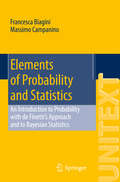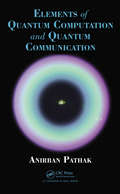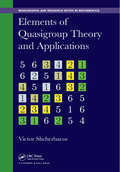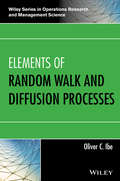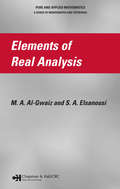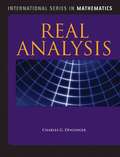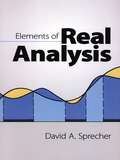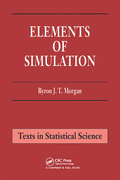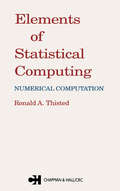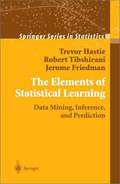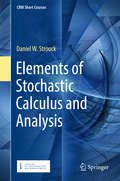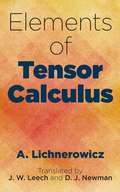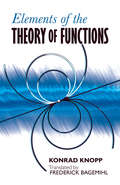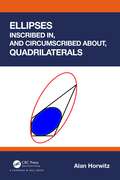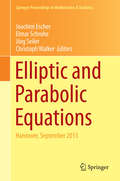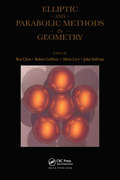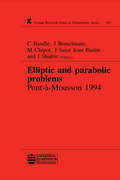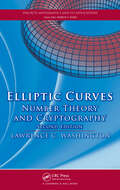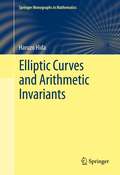- Table View
- List View
Elements of Probability and Statistics
by Francesca Biagini Massimo CampaninoThis bookprovides an introduction to elementary probability and to Bayesianstatistics using de Finetti's subjectivist approach. One of the featuresof this approach is that it does not require the introductionof sample space - a non-intrinsic concept that makes the treatment ofelementary probability unnecessarily complicate - but introduces asfundamental the concept of random numbers directly related to their interpretationin applications. Events become a particular case of random numbers andprobability a particular case of expectation when it is applied to events. The subjective evaluation of expectation and of conditional expectation isbased on an economic choice of an acceptable bet or penalty. Theproperties of expectation and conditional expectation are derived by applyinga coherence criterion that the evaluation has to follow. The book is suitablefor all introductory courses in probability and statistics for students inMathematics, Informatics, Engineering, and Physics.
Elements of Quantum Computation and Quantum Communication
by Anirban PathakWhile there are many available textbooks on quantum information theory, most are either too technical for beginners or not complete enough. Filling the gap, this book gives a clear, self-contained introduction to quantum computation and communication. Exploring recent developments and open questions in the field, it prepares readers for further study and helps them understand more advanced texts and journal papers. Along with thought-provoking cartoons and brief biographies of key players in the field, each chapter includes examples, references, exercises, and problems with detailed solutions.
Elements of Quasigroup Theory and Applications (Chapman & Hall/CRC Monographs and Research Notes in Mathematics)
by Victor ShcherbacovThis book provides an introduction to quasigroup theory along with new structural results on some of the quasigroup classes. Many results are presented with some of them from mathematicians of the former USSR. These included results have not been published before in the western mathematical literature. In addition, many of the achievements obtained with regard to applications of quasigroups in coding theory and cryptology are described.
Elements of Random Walk and Diffusion Processes
by Oliver C. IbePresents an important and unique introduction to random walk theoryRandom walk is a stochastic process that has proven to be a useful model in understanding discrete-state discrete-time processes across a wide spectrum of scientific disciplines. Elements of Random Walk and Diffusion Processes provides an interdisciplinary approach by including numerous practical examples and exercises with real-world applications in operations research, economics, engineering, and physics.Featuring an introduction to powerful and general techniques that are used in the application of physical and dynamic processes, the book presents the connections between diffusion equations and random motion. Standard methods and applications of Brownian motion are addressed in addition to Levy motion, which has become popular in random searches in a variety of fields. The book also covers fractional calculus and introduces percolation theory and its relationship to diffusion processes.With a strong emphasis on the relationship between random walk theory and diffusion processes, Elements of Random Walk and Diffusion Processes features:Basic concepts in probability, an overview of stochastic and fractional processes, and elements of graph theoryNumerous practical applications of random walk across various disciplines, including how to model stock prices and gambling, describe the statistical properties of genetic drift, and simplify the random movement of molecules in liquids and gasesExamples of the real-world applicability of random walk such as node movement and node failure in wireless networking, the size of the Web in computer science, and polymers in physicsPlentiful examples and exercises throughout that illustrate the solution of many practical problemsElements of Random Walk and Diffusion Processes is an ideal reference for researchers and professionals involved in operations research, economics, engineering, mathematics, and physics. The book is also an excellent textbook for upper-undergraduate and graduate level courses in probability and stochastic processes, stochastic models, random motion and Brownian theory, random walk theory, and diffusion process techniques.
Elements of Real Analysis (Chapman & Hall/CRC Pure and Applied Mathematics)
by M.A. Al-Gwaiz S.A. ElsanousiFocusing on one of the main pillars of mathematics, Elements of Real Analysis provides a solid foundation in analysis, stressing the importance of two elements. The first building block comprises analytical skills and structures needed for handling the basic notions of limits and continuity in a simple concrete setting while the second component in
Elements Of Real Analysis (G - Reference, Information And Interdisciplinary Subjects)
by Charles G. DenlingerElementary Real Analysis is a core course in nearly all mathematics departments throughout the world. It enables students to develop a deep understanding of the key concepts of calculus from a mature perspective. Elements of Real Analysis is a student-friendly guide to learning all the important ideas of elementary real analysis, based on the author's many years of experience teaching the subject to typical undergraduate mathematics majors. It avoids the compact style of professional mathematics writing, in favor of a style that feels more comfortable to students encountering the subject for the first time. It presents topics in ways that are most easily understood, without sacrificing rigor or coverage. In using this book, students discover that real analysis is completely deducible from the axioms of the real number system. They learn the powerful techniques of limits of sequences as the primary entry to the concepts of analysis, and see the ubiquitous role sequences play in virtually all later topics. They become comfortable with topological ideas, and see how these concepts help unify the subject. Students encounter many interesting examples, including "pathological" ones, that motivate the subject and help fix the concepts. They develop a unified understanding of limits, continuity, differentiability, Riemann integrability, and infinite series of numbers and functions.
Elements of Real Analysis
by David A. SprecherThis classic text in introductory analysis delineates and explores the intermediate steps between the basics of calculus and the ultimate stage of mathematics: abstraction and generalization.Since many abstractions and generalizations originate with the real line, the author has made it the unifying theme of the text, constructing the real number system from the point of view of a Cauchy sequence (a step which Dr. Sprecher feels is essential to learn what the real number system is).The material covered in Elements of Real Analysis should be accessible to those who have completed a course in calculus. To help give students a sound footing, Part One of the text reviews the fundamental concepts of sets and functions and the rational numbers. Part Two explores the real line in terms of the real number system, sequences and series of number and the structure of point sets. Part Three examines the functions of a real variable in terms of continuity, differentiability, spaces of continuous functions, measure and integration, and the Fourier series.An especially valuable feature of the book is the exercises which follow each section. There are over five hundred, ranging from the simple to the highly difficult, each focusing on a concept previously introduced.
Elements of Simulation (Chapman And Hall/crc Texts In Statistical Science Ser. #4)
by Byron J.T. MorganThe use of simulation in statistics dates from the start of the 20th century, coinciding with the beginnings of radio broadcasting and the invention of television. Just as radio and television are now commonplace in our everyday lives, simulation methods are now widely used throughout the many branches of statistics, as can be readily appreciated from reading Chapters 1 and 9. The book has grown out of a fifteen-hour lecture course given to third-year mathematics undergraduates at the University of Kent, and it could be used either as an undergraduate or a postgraduate text. Simulation may either be taught as an operational research tool in its own right, or as a mathematical method which cements together different parts of statistics and which may be used in a variety of lecture courses. In the last three chapters indications are made of the varied uses of simulation throughout statistics. Alternatively, simulation may be used to motivate subjects such as the teaching of distribution theory and the manipulation of random variables, and Chapters 4 and 5 especially will hopefully be useful in this respect.
Elements of Statistical Computing: NUMERICAL COMPUTATION
by R.A. ThistedStatistics and computing share many close relationships. Computing now permeates every aspect of statistics, from pure description to the development of statistical theory. At the same time, the computational methods used in statistical work span much of computer science. Elements of Statistical Computing covers the broad usage of computing in statistics. It provides a comprehensive account of the most important computational statistics. Included are discussions of numerical analysis, numerical integration, and smoothing.The author give special attention to floating point standards and numerical analysis; iterative methods for both linear and nonlinear equation, such as Gauss-Seidel method and successive over-relaxation; and computational methods for missing data, such as the EM algorithm. Also covered are new areas of interest, such as the Kalman filter, projection-pursuit methods, density estimation, and other computer-intensive techniques.
The Elements Of Statistical Learning: Data Mining, Inference, And Prediction (Series In Statistics)
by Jerome Friedman Trevor Hastie Robert TibshiraniDuring the past decade there has been an explosion in computation and information technology. With it have come vast amounts of data in a variety of fields such as medicine, biology, finance, and marketing. The challenge of understanding these data has led to the development of new tools in the field of statistics, and spawned new areas such as data mining, machine learning, and bioinformatics. Many of these tools have common underpinnings but are often expressed with different terminology. This book describes the important ideas in these areas in a common conceptual framework. While the approach is statistical, the emphasis is on concepts rather than mathematics. Many examples are given, with a liberal use of color graphics. It should be a valuable resource for statisticians and anyone interested in data mining in science or industry. The book's coverage is broad, from supervised learning (prediction) to unsupervised learning. The many topics include neural networks, support vector machines, classification trees and boosting---the first comprehensive treatment of this topic in any book. <p><p> This major new edition features many topics not covered in the original, including graphical models, random forests, ensemble methods, least angle regression & path algorithms for the lasso, non-negative matrix factorization, and spectral clustering. There is also a chapter on methods for ``wide'' data (p bigger than n), including multiple testing and false discovery rates.
Elements of Stochastic Calculus and Analysis (Crm Short Courses Ser.)
by Daniel W. StroockThis book gives a somewhat unconventional introduction to stochastic analysis. Although most of the material coveredhere has appeared in other places, this book attempts to explain the core ideas on which that material is based. As a consequence, the presentation is more an extended mathematical essay than a ``definition,lemma, theorem'' text. In addition, it includes several topics that are not usually treated elsewhere. For example,Wiener's theory of homogeneous chaos is discussed, Stratovich integration is given a novel development and applied to derive Wong and Zakai's approximation theorem, and examples are given of the application ofMalliavin's calculus to partial differential equations. Each chapter concludes with several exercises, some of which are quite challenging. The book is intended for use by advanced graduate students and researchmathematicians who may be familiar with many of the topics but want to broaden their understanding of them.
Elements of Tensor Calculus (Dover Books on Mathematics)
by A. Lichnerowicz D. J. Newman J. W. LeechThis classic introductory text, geared toward undergraduate students of mathematics, is the work of an internationally renowned authority on tensor calculus. The two-part treatment offers a rigorous presentation of tensor calculus as a development of vector analysis as well as discussions of the most important applications of tensor calculus.Starting with a chapter on vector spaces, Part I explores affine Euclidean point spaces, tensor algebra, curvilinear coordinates in Euclidean space, and Riemannian spaces. Part II examines the use of tensors in classical analytical dynamics and details the role of tensors in special relativity theory. The book concludes with a brief presentation of the field equations of general relativity theory.
Elements of the Theory of Functions
by Konrad Knopp Frederick BagemihlThis well-known book provides a clear and concise review of general function theory via complex variables. Suitable for undergraduate math majors, the treatment explores only those topics that are simplest but are also most important for the development of the theory. Prerequisites include a knowledge of the foundations of real analysis and of the elements of analytic geometry.The text begins with an introduction to the system of complex numbers and their operations. Then the concept of sets of numbers, the limit concept, and closely related matters are extended to complex quantities. Final chapters examine the elementary functions, including rational and linear functions, exponential and trigonometric functions, and several others as well as their inverses, including the logarithm and the cyclometric functions. Numerous examples clarify the essential ideas, and proofs are expressed in a direct manner without sacrifice of completeness or rigor.
Elevate Science, Grade 1
by Zipporah Miller Michael J. Padilla Michael E. WysessionNIMAC-sourced textbook
Elimination of Infectious Diseases from the South-East Asia Region: Keeping the Promise (SpringerBriefs in Public Health)
by Poonam Khetrapal SinghThis book discusses the historical context, country experience, and best practices that led to eliminating infectious diseases from the WHO’s South-East Asia Region, such as malaria, lymphatic filariasis, yaws, trachoma, and mother-to-child HIV in the mid-twentieth and twenty-first century. The UN Sustainable Development Goals (3.3) targets to end AIDS, tuberculosis, malaria, and neglected tropical diseases and combat hepatitis, water-borne diseases and other communicable diseases by 2030. In this context, this book is of high significance to countries from the SEA region and around the globe. It helps create national strategies and action plans on infectious disease elimination and thus attaining SDG 3.3.
The Ellipse
by Arthur MazerExplores the development of the ellipse and presents mathematical concepts within a rich, historical contextThe Ellipse features a unique, narrative approach when presenting the development of this mathematical fixture, revealing its parallels to mankind's advancement from the Counter-Reformation to the Enlightenment. Incorporating illuminating historical background and examples, the author brings together basic concepts from geometry, algebra, trigonometry, and calculus to uncover the ellipse as the shape of a planet's orbit around the sun.The book begins with a discussion that tells the story of man's pursuit of the ellipse, from Aristarchus to Newton's successful unveiling nearly two millenniums later. The narrative draws insightful similarities between mathematical developments and the advancement of the Greeks, Romans, Medieval Europe, and Renaissance Europe. The author begins each chapter by setting the historical backdrop that is pertinent to the mathematical material that is discussed, equipping readers with the knowledge to fully grasp the presented examples and derive the ellipse as the planetary pathway. All topics are presented in both historical and mathematical contexts, and additional mathematical excursions are clearly marked so that readers have a guidepost for the materials' relevance to the development of the ellipse.The Ellipse is an excellent book for courses on the history of mathematics at the undergraduate level. It is also a fascinating reference for mathematicians, engineers, or anyone with a general interest in historical mathematics.
Ellipses Inscribed in, and Circumscribed about, Quadrilaterals
by Alan HorwitzThe main focus of this book is disseminating research results regarding the pencil of ellipses inscribing arbitrary convex quadrilaterals. In particular, the author proves that there is a unique ellipse of maximal area, EA, and a unique ellipse of minimal eccentricity, EI, inscribed in Q. Similar results are also proven for ellipses passing through the vertices of a convex quadrilateral along with some comparisons with inscribed ellipses. Special results are also given for parallelograms.Researchers in geometry and applied mathematics will find this unique book of interest. Software developers, image processors along with geometers, mathematicians, and statisticians will be very interested in this treatment of the subject of inscribing and circumscribing ellipses with the comprehensive treatment here.Most of the results in this book were proven by the author in several papers listed in the references at the end. This book gathers results in a unified treatment of the topics while also shortening and simplifying many of the proofs.This book also contains a separate section on algorithms for finding ellipses of maximal area or of minimal eccentricity inscribed in, or circumscribed about, a given quadrilateral and for certain other topics treated in this book.Anyone who has taken calculus and linear algebra and who has a basic understanding of ellipses will find it accessible.
Ellipsoidal Harmonics Theory and Applications
by George DassiosThe sphere is what might be called a perfect shape. Unfortunately nature is imperfect and many bodies are better represented by an ellipsoid. The theory of ellipsoidal harmonics, originated in the 19th century, could only be seriously applied with the kind of computational power available in recent years. This, therefore, is the first book devoted to ellipsoidal harmonics. Topics are drawn from geometry, physics, biosciences and inverse problems. It contains classical results as well as new material, including ellipsoidal bi-harmonic functions, the theory of images in ellipsoidal geometry and vector surface ellipsoidal harmonics, which exhibit an interesting analytical structure. Extended appendices provide everything one needs to solve formally boundary value problems. End-of-chapter problems complement the theory and test the reader's understanding. The book serves as a comprehensive reference for applied mathematicians, physicists, engineers and for anyone who needs to know the current state of the art in this fascinating subject.
Elliptic and Modular Functions from Gauss to Dedekind to Hecke
by Ranjan RoyThis thorough work presents the fundamental results of modular function theory as developed during the nineteenth and early-twentieth centuries. It features beautiful formulas and derives them using skillful and ingenious manipulations, especially classical methods often overlooked today. Starting with the work of Gauss, Abel, and Jacobi, the book then discusses the attempt by Dedekind to construct a theory of modular functions independent of elliptic functions. The latter part of the book explains how Hurwitz completed this task and includes one of Hurwitz's landmark papers, translated by the author, and delves into the work of Ramanujan, Mordell, and Hecke. For graduate students and experts in modular forms, this book demonstrates the relevance of these original sources and thereby provides the reader with new insights into contemporary work in this area.
Elliptic and Parabolic Equations
by Joachim Escher Elmar Schrohe Jörg Seiler Christoph WalkerThe international workshop on which this proceedings volume is based on brought together leading researchers in the field of elliptic and parabolic equations. Particular emphasis was put on the interaction between well-established scientists and emerging young mathematicians, as well as on exploring new connections between pure and applied mathematics. The volume contains material derived after the workshop taking up the impetus to continue collaboration and to incorporate additional new results and insights.
Elliptic and Parabolic Methods in Geometry
by Ben Chow Robert Gulliver Silvio Levy John SullivanThis book documents the results of a workshop held at the Geometry Center (University of Minnesota, Minneapolis) and captures the excitement of the week.
Elliptic and Parabolic Problems: Pont-A-Mousson 1994, Volume 325 (Chapman And Hall/crc Research Notes In Mathematics Ser. #325)
by C Bandle Michel Chipot Josef Bemelmans J Saint Paulin I ShafrirThis Research Note presents some recent advances in various important domains of partial differential equations and applied mathematics including equations and systems of elliptic and parabolic type and various applications in physics,mechanics and engineering.These topics are now part of various areas of science and haveexperienced tremendous development during the last decades.-------------------------------------
Elliptic Curves: Number Theory and Cryptography, Second Edition (Discrete Mathematics and Its Applications)
by Lawrence C. WashingtonLike its bestselling predecessor, Elliptic Curves: Number Theory and Cryptography, Second Edition develops the theory of elliptic curves to provide a basis for both number theoretic and cryptographic applications. With additional exercises, this edition offers more comprehensive coverage of the fundamental theory, techniques, and application
Elliptic Curves and Arithmetic Invariants
by Haruzo HidaThis book contains a detailed account of the result of the author's recent Annals paper and JAMS paper on arithmetic invariant, including μ-invariant, L-invariant, and similar topics. This book can be regarded as an introductory text to the author's previous book p-Adic Automorphic Forms on Shimura Varieties. Written as a down-to-earth introduction to Shimura varieties, this text includes many examples and applications of the theory that provide motivation for the reader. Since it is limited to modular curves and the corresponding Shimura varieties, this book is not only a great resource for experts in the field, but it is also accessible to advanced graduate students studying number theory. Key topics include non-triviality of arithmetic invariants and special values of L-functions; elliptic curves over complex and p-adic fields; Hecke algebras; scheme theory; elliptic and modular curves over rings; and Shimura curves.
Elliptic Curves, Modular Forms and Iwasawa Theory
by David Loeffler Sarah Livia ZerbesCelebrating one of the leading figures in contemporary number theory - John H. Coates - on the occasion of his 70th birthday, this collection of contributions covers a range of topics in number theory, concentrating on the arithmetic of elliptic curves, modular forms, and Galois representations. Several of the contributions in this volume were presented at the conference Elliptic Curves, Modular Forms and Iwasawa Theory, held in honour of the 70th birthday of John Coates in Cambridge, March 25-27, 2015. The main unifying theme is Iwasawa theory, a field that John Coates himself has done much to create. This collection is indispensable reading for researchers in Iwasawa theory, and is interesting and valuable for those in many related fields.
